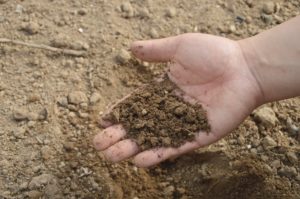Soil Sampling for Homeowners and Gardeners
go.ncsu.edu/readext?633771
en Español / em Português
El inglés es el idioma de control de esta página. En la medida en que haya algún conflicto entre la traducción al inglés y la traducción, el inglés prevalece.
Al hacer clic en el enlace de traducción se activa un servicio de traducción gratuito para convertir la página al español. Al igual que con cualquier traducción por Internet, la conversión no es sensible al contexto y puede que no traduzca el texto en su significado original. NC State Extension no garantiza la exactitud del texto traducido. Por favor, tenga en cuenta que algunas aplicaciones y/o servicios pueden no funcionar como se espera cuando se traducen.
Português
Inglês é o idioma de controle desta página. Na medida que haja algum conflito entre o texto original em Inglês e a tradução, o Inglês prevalece.
Ao clicar no link de tradução, um serviço gratuito de tradução será ativado para converter a página para o Português. Como em qualquer tradução pela internet, a conversão não é sensivel ao contexto e pode não ocorrer a tradução para o significado orginal. O serviço de Extensão da Carolina do Norte (NC State Extension) não garante a exatidão do texto traduzido. Por favor, observe que algumas funções ou serviços podem não funcionar como esperado após a tradução.
English
English is the controlling language of this page. To the extent there is any conflict between the English text and the translation, English controls.
Clicking on the translation link activates a free translation service to convert the page to Spanish. As with any Internet translation, the conversion is not context-sensitive and may not translate the text to its original meaning. NC State Extension does not guarantee the accuracy of the translated text. Please note that some applications and/or services may not function as expected when translated.
Collapse ▲September is an ideal time for homeowners and gardeners to take soil samples for their cool-seasons grasses, fall vegetable garden, as well as other landscape plants. This is a good time of year for sampling because the soil lab within the N.C. Department of Agriculture & Consumer Services begins to process tens of thousands of samples beginning in late fall through winter. This service is free to North Carolina residents between April 1st and November 26th each year. Peak testing season begins November 27th when a $4.00 fee per sample is initiated.
Late summer and early fall are good times to take samples to determine if your landscape needs lime, as well as determining what nutrients are readily available. If the soil report tells you that lime is needed, then it should be applied right away. It takes time for lime to alter the pH of soil. On the pH scale of 1.0-14.0, with 7.0 being neutral, a good pH for most plants would fall somewhere between 5.8 and 6.5. North Carolina soils are naturally on the more acidic side and can have a pH as low as 3.8 in severe situations. With this low pH there are many nutrients that are not accessible by plants, thus leading to poor health and poor growth.
A good rule of thumb is to sample established lawns, trees, shrubs, and other areas once every three years. Make sure you collect the soil only from areas that have not been limed or fertilized for at least eight weeks. When collecting your samples use stainless steel or chromium plated sampling tools and plastic buckets to avoid contaminating the samples with traces of chemical elements from sampling tools. Avoid brass, bronze, or galvanized tools. When sampling for grasses samples to a depth of 4-6 inches since grass roots are the most prevalent there. When establishing lawns, landscaping projects, and gardens sample to a depth of at least 6-8 inches. For large areas take several samples (10-20) and mix them together in the plastic bucket; removing all roots, rocks, or other debris that might contaminate the sample.
Your local North Carolina Cooperative Extension office has free soil boxes and forms for the general public. We also have forms for nematode assays, and plant/waste/solution analyses among many other services that are available. The Agronomic Division recommends about 0.5 pounds of soil for an adequate sample. The boxes used for sampling have a “fill line” that shows the amount of soil needed. When the soil lab is finished with your sample you will receive a report with the analysis. A cover sheet called “Understanding the Soil Test Report” comes with your analysis and defines all the parameters shown on the report.
For more information about soil testing, assistance with reading your analysis, or if you have other questions, please contact Colby Griffin, colby_griffin@ncsu.edu or 919-496-3344.





